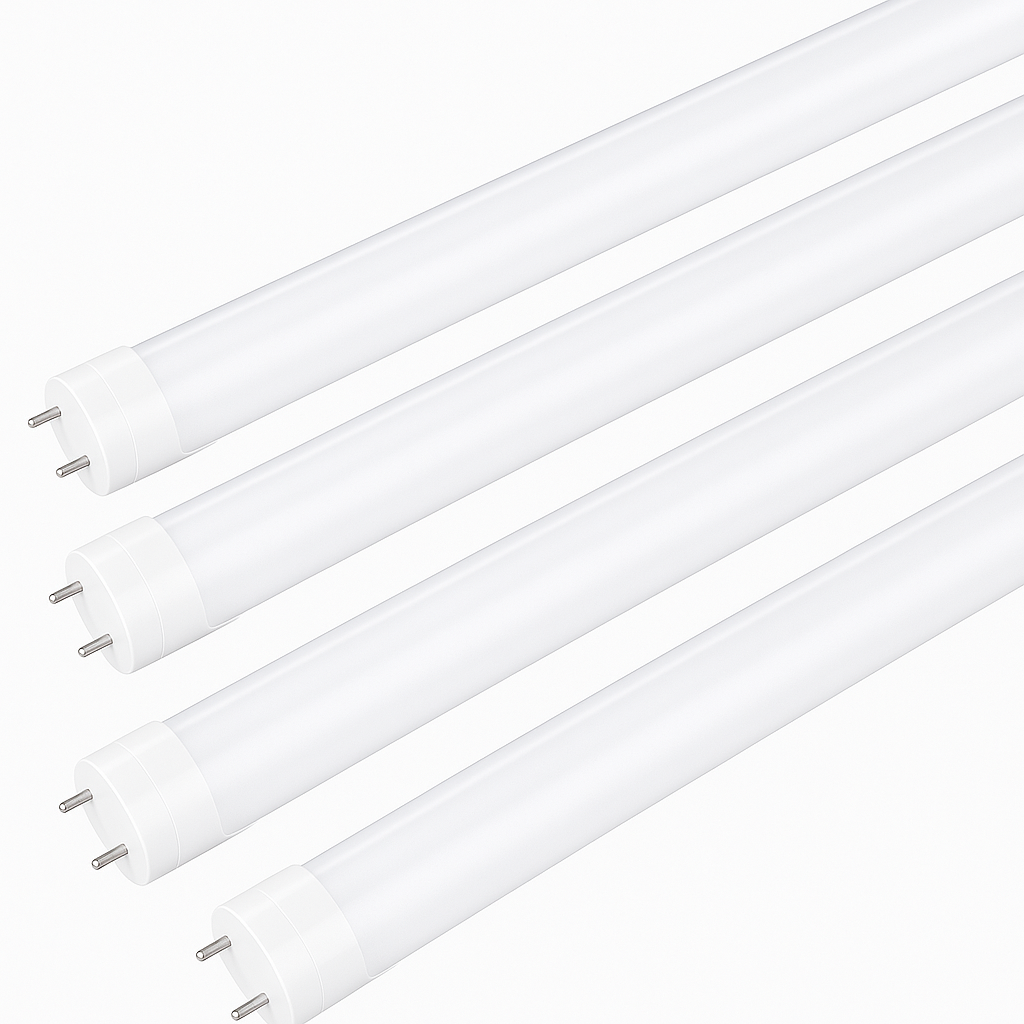For many years, fluorescent tubes were the primary light source in homes, offices, and public spaces. However, with the advancement of lighting technology, LED tube lights have gradually replaced traditional fluorescent lamps. They are not only more energy-efficient and long-lasting but also reduce maintenance costs while providing a more comfortable lighting experience.
When choosing LED tube lights, it’s important to consider your actual situation. If it’s a new installation, you have more freedom to choose between integrated fixtures or separate tubes with brackets, and then decide on the length and color temperature. If you are replacing old fluorescent tubes, special attention should be paid to socket type, tube length, and wattage equivalence.
1. Common Types of LED Tube Lights
LED tube lights come in many types, mainly differing in diameter, socket type, and application scenarios. The most common are T5, T8, T10, T12, U-shaped, and PL-C tubes:
-
T5 (Approx. 16 mm diameter, G5 socket)
Compact in size with good heat dissipation, commonly used in integrated fixtures. Its slim design makes it ideal for confined spaces such as under-cabinet lighting, desks, display cases, or office ceilings that require even illumination. -
T8 (Approx. 26 mm diameter, G13 socket)
The most popular and widely used type. T8 LED tubes match the size of traditional fluorescent tubes, making them easy to replace in homes, shops, offices, schools, and parking lots. They are often seen as the direct substitute for fluorescent lamps with low retrofit cost. -
T10/T12 (Approx. 30–38 mm diameter)
Thicker than T8, these tubes are often found in older lighting systems such as factories or public buildings. As they are gradually phased out, LED replacements are less common. If needed, it’s crucial to confirm socket compatibility and fixture space. -
U-shaped / PL-C Tubes
Designed for compact spaces, often used in recessed ceiling fixtures, commercial displays, or task lighting. When choosing LED replacements, pay close attention to socket types (such as 2-pin or 4-pin) and whether the fixture supports direct retrofit.
In general, T8 tubes are the most versatile and widely applicable, T5 tubes are better suited for new designs or integrated fixtures, while T10/T12, U-shaped, and PL-C tubes are usually for older or special applications that require careful compatibility checks.
2. Choosing LED Tubes for New Installations
For new spaces or renovations, selection is more flexible since there’s no restriction from existing fixtures. In this case, you can first decide the form of the tube light, then choose the length, color temperature, and brightness.
1. Tube Formats
-
Separate Tubes (e.g., T8/T5 tubes with brackets)
-
Advantages: Tubes and fixtures are independent, making replacement easier—only the tube needs to be changed later.
-
Applications: Office ceilings, classrooms, hallways, or any space requiring uniform linear lighting.
-
-
Integrated Tube Lights (T5/T8 integrated fixtures)
-
Advantages: Tube and fixture are combined, usually with a built-in power cord and switch, making installation much easier—just mount and plug in.
-
Applications: Garages, kitchens, under-cabinet lighting, storage areas, basements, or other utility spaces where quick installation and convenience are important.
-
2. Key Considerations
-
Length: Common options are 2 ft (about 60 cm), 3 ft (about 90 cm), and 4 ft (about 120 cm). Larger spaces generally require longer and higher-wattage tubes to ensure even lighting.
-
Color Temperature:
-
3000K Warm White → Soft, yellowish light, ideal for bedrooms and living rooms to create a cozy atmosphere.
-
4000K Neutral White → Balanced, neutral tone suitable for kitchens, study areas, and offices.
-
5000K Daylight White → Bright and clear light close to natural daylight, commonly used in offices, shops, and work areas that require high visibility.
-
-
Brightness & Wattage: Higher wattage provides more brightness. Smaller rooms and households usually need lower wattage, while large areas (like classrooms or warehouses) may require higher wattage. Be mindful that excessive brightness may cause glare, so always choose based on the environment.
3. Key Points When Replacing Old Fluorescent Tubes
When upgrading from fluorescent tubes to LED, careful attention is needed to ensure compatibility.
1. Socket Type
-
T8 tubes → usually use G13 sockets
-
T5 tubes → usually use G5 sockets
Always confirm the socket type before purchasing to avoid mismatches.
2. Length Consistency
LED tubes generally match fluorescent lengths: 2 ft (60 cm), 3 ft (90 cm), and 4 ft (120 cm). Always keep the same length when replacing.
3. Color Consistency
If you are used to a certain color temperature, stick to the same one in LED tubes to avoid discomfort caused by changes in lighting tone.
4. Wattage Equivalence
While LED tubes consume less power, their brightness is comparable to fluorescent tubes. Common replacements are:
| Fluorescent Lamp Wattage | Recommended LED Tube Wattage |
|---|---|
| 20W Fluorescent | 10W LED Tube |
| 30W Fluorescent | 15W LED Tube |
| 40W Fluorescent | 20W LED Tube |
This ensures brightness is maintained while significantly reducing energy consumption.
4. Example Products and Accessories
Here are some commonly used models and accessories for different applications:
| Category | Examples |
|---|---|
| T8 Tubes (Fluorescent Replacements) | 2ft 10W / 3ft 15W / 4ft 20W |
| T5 Integrated Fixtures | 2ft 10W / 3ft 15W / 4ft 20W |
| Low Voltage & Special Applications | AC/DC 12–36V T8 / 12V Mini T5 / High Output T5/T6 |
| Brackets & Accessories | Single Tube Bracket / Double Tube Bracket / Clear Cover Fixture / Extension Cable / Power Cord with Switch |
Conclusion
In summary, choosing the right LED tube light depends on the situation:
-
New installations → Flexible choice between separate tubes or integrated fixtures, then decide on length, color temperature, and brightness.
-
Replacing old tubes → Confirm socket type, tube length, and color temperature, and refer to the wattage equivalence between fluorescent and LED.
Making the right choice not only reduces energy consumption but also improves the lighting experience, making your space more comfortable and efficient.

